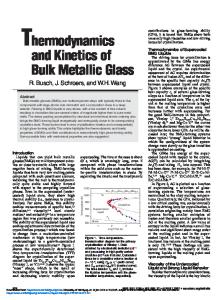Metastability and Properties of Metallic Bulk Glass Forming Alloys
- PDF / 1,193,048 Bytes
- 12 Pages / 414.72 x 648 pts Page_size
- 8 Downloads / 318 Views
INTRODUCTION Metallic bulk amorphous alloys with a fully non-crystalline glassy atomic structure and dimensions of several hundred cubic-centimeters can be produced at relatively
slow cooling rates using conventional casting techniques [1,2,3]. These new materials on the basis of multi-component eutectics have a huge potential as advanced engineering materials due to their excellent processing capabilities in the undercooled liquid state and excellent mechanical properties, such as wear resistance and mechanical strength. The pseudo-ternary alloy (Zr4lTil3)(Cul3Nil0)Be23 which is most stable against crystallization has been the main focus of the investigations described here and is compared with the undercooling characteristics of pure metals and other good glass forming alloys. Furthermore, these materials are sufficiently stable against crystallization in the state of the highly undercooled liquid in the range of about 100 K above the glass transition temperature Tg and give new insight into the dynamical and thermal properties of the highly undercooled liquid state and the glass transition itself [4]. The properties of interest include the temperature dependent thermodynamic properties, such as entropy, enthalpy and Gibbs free energy, volume (density), viscosity and mechanical properties such as the elastic moduli, and hardness These new alloys have considerable potential as advanced engineering materials due to their excellent processing capabilities of the undercooled liquid, improved wear resistance, low coefficient of friction, high strength and excellent corrosion resistance.
307
Mat. Res. Soc. Symp. Proc. Vol. 455 ©1997Materials Research Society
EXPERIMENT Eutectic alloys with the composition Zr41Ti13Cul3Nil0Be23 have been prepared by induction melting in a special chamber under ultra clean conditions [5]. By controlled cooling procedures the samples could be crystallized below the eutectic temperature or undercooled over the entire undercooling range resulting in a glass. Typical cooling rates in this case were about 100 K / sec with a sample size of several cm 3 . After preparation, these samples were annealed in different time and temperature steps and investigated in terms of their thermal and mechanical properties. Scanning electron microscopy and X-ray diffraction allowed to characterize the microstructural development. Further thermal analysis (Perkin Elmer DSC7) and Dynamic Mechanical Analysis (Perkin Elmer DMA 7e) has been employed to measure the specific heat cp and heat of crystallization as well as thermal expansion behavior and the temperature dependent elastic modulus. These investigations of microstructure - property relationships were extended to hardness measurements using conventional microhardness and nanoindentation techniques. RESULTS Structural Properties Heating the glass up to temperatures higher than about 80 K above the glass transition temperature leads eventually to crystallization. The crystallization occurs in three distinct exothermic steps. More details on the phase ana
Data Loading...











